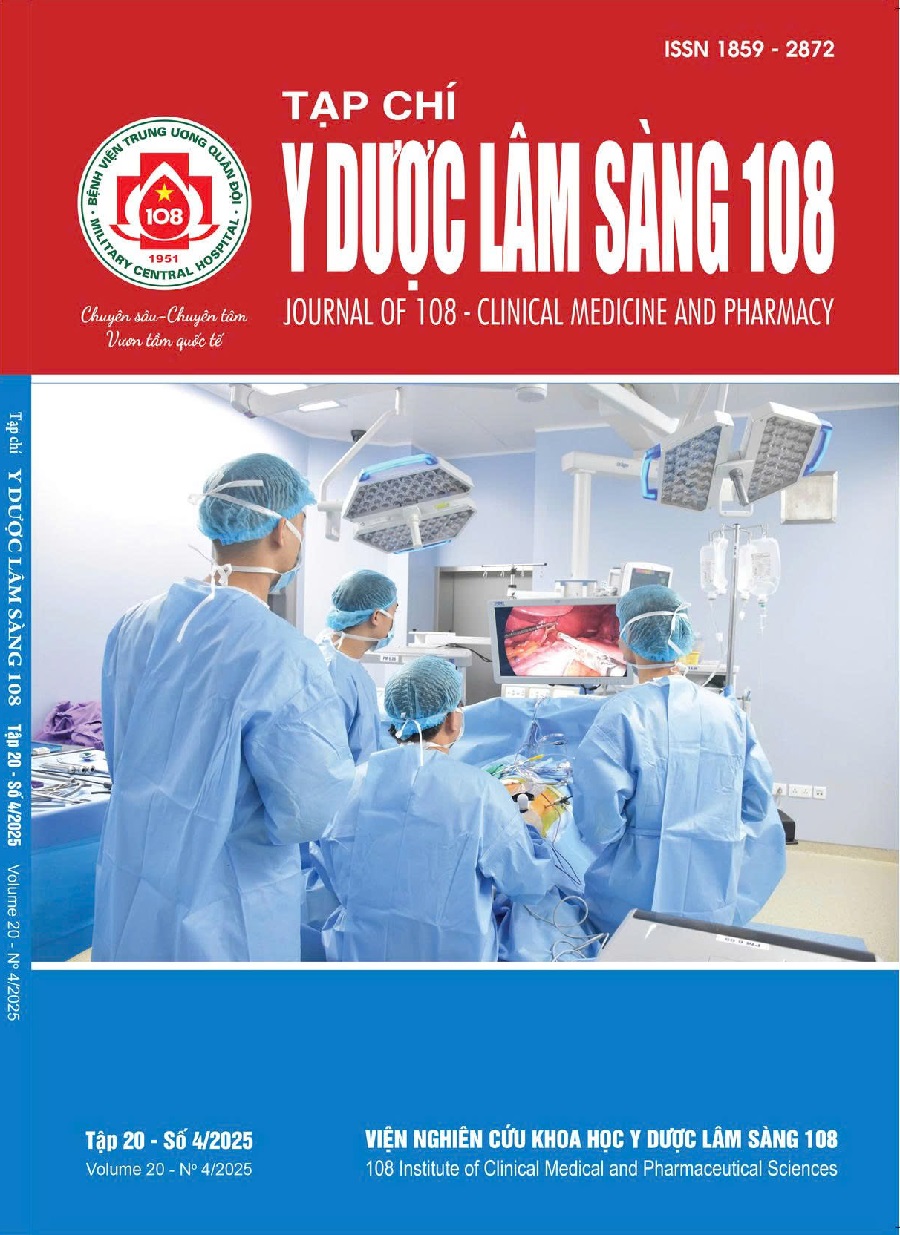Evaluation of clinical and paraclinical characteristics of patients with descending thoracic aortic aneurysm at 108 Military Central Hospital
Main Article Content
Keywords
Abstract
Background: Descending thoracic aortic aneurysm is a serious condition that requires early detection and treatment. It commonly occurs in elderly patients and those with a history of hypertension, smoking, coronary artery disease, or chronic lung disease. This study aims to evaluate the clinical and paraclinical characteristics of patients with descending thoracic aortic aneurysm at 108 Military Central Hospital. Subject and method: A cross-sectional descriptive study was conducted on 38 patients diagnosed with descending thoracic aortic aneurysm who were treated at 108 Military Central Hospital. Patients were assessed for their clinical and paraclinical characteristics. Data were entered and analyzed using SPSS version 22.0. Result: A total of 38 patients participated in the study, with a mean age of 67.8 ± 11.0 years. Males accounted for 84.2% of the sample. The proportion of patients with a history of stroke was 26.3%, and those with hypertension accounted for 92.1%. The most common symptom was chest pain (63.2%). The average diameter of the aneurysm was 37 ± 14.6cm. Conclusion: The study provides an initial overview of the clinical and paraclinical features of patients with descending thoracic aortic aneurysm, showing a predominance of male patients and those with underlying hypertension and metabolic disorders. Further research on treatment and intervention methods is recommended.
Article Details
References
2. Raimund E, Victor A, Catherine B et al (2014) ESC Guidelines on the diagnosis and treatment of aortic diseases: document covering acute and chronic aortic diseases of the thoracic and abdominal aorta of the adult The Task Force for the Diagnosis and Treatment of Aortic Diseases of the European Society of Cardiology (ESC). J European heart journal 35(41): 2873-2926.
3. Nguyễn Ngọc Rạng (2012) Thiết kế nghiên cứu thống kê y học. Nhà xuất bản Y học.
4. Trần Quyết Tiến, Phan Quốc Hùng (2015) Can thiệp nội mạch điều trị phình động mạch chủ tại bệnh viện Chợ Rẫy: Một số kết quả bước đầu. Y học Việt Nam 1: 39-44.
5. Lâm Triều Phát, Trần Quyết Tiến (2021) Kết quả sớm sau can thiệp đặt ống ghép nội mạch điều trị phình động mạch chủ ngực. Y Học Việt Nam 504 (01): 1-6.
6. Trần Văn Huy (2018) Khuyến cáo chẩn đoán và điều trị tăng huyết áp của ACC/AHA và khuyến cáo ESC/ESH và VNHA/VSH. Khuyến cáo của Phân hội Tăng huyết áp Việt Nam
7. ElSayed NA, Aleppo G, Aroda VR và cộng sự (2023) Classification and Diagnosis of Diabetes: Standards of Care in Diabetes 2023. Diabetes Care 46(1): 19-40.
8. Mach F, Baigent C, Catapano AL et al (2019). ESC/EAS Guidelines for the management of dyslipidaemias: lipid modification to reduce cardiovascular risk: The Task Force for the management of dyslipidaemias of the European Society of Cardiology (ESC) and European Atherosclerosis Society (EAS). Eur Heart J 00: 1-78.
9. Yakar HI, Gunen H, Pehlivan E và cộng sự (2017) The role of tuberculosis in COPD. Int J Chron Obstruct Pulmon Dis, 12: 323-329.
10. Elhassan EA, Schrier RW (2013) Acute kidney injury, textbook of critical care, sixth edition. Jean - louis Vincent, elsevier sauders. 883-893.
11. Kalkwarf KJ, Cotton BA (2017) Resuscitation for Hypovolemic Shock. Surg Clin North Am 97(6): 1307-1321.
12. Hồ Minh Tuấn (2023) Nghiên cứu đặc điểm lâm sàng, cận lâm sàng và kết quả can thiệp da ở bệnh nhân hẹp 03 thân động mạch vành mạn tính có syntax ≤ 22. Tóm tắt Luận án tiến sĩ y học 2023.
 ISSN: 1859 - 2872
ISSN: 1859 - 2872
